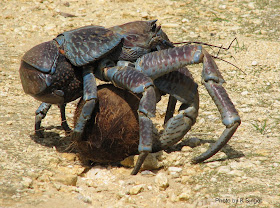Don't let the fish throw you off; Greg is a true crab lover all the way! While not studying snow crab genetics, he's playing dress-up with decorator crabs. He's a model for the rest of us!
Age: 27
Degree: MS Marine Biology
Current City: Fairbanks
1. Describe your project, in 4 sentences or less.
My project focuses on defining the genetic population structure of snow crab within the Bering, Chukchi and Beaufort Seas. I'm using 7 microsatellite markers and have 613 samples collected from 13 locations. The hypothesis I'm testing is that due to their long distance larval dispersal abilities the entire stock will have low genetic differentiation. This is an important question for management of the current fishery and figuring out what's going on in the arctic.
a lovely C. opilio
2. Have you come across any opilio-bairdi hybrids, and if so, have you included them in your genetic analysis? In your opinion, are they truly 2 separate species (C. opilio and C. bairdi) , or simply subspecies of one another? Let’s fuel the debate!
To my knowledge, none of the crabs sampled were hybrids; however, that's hard to tell since identifying them can be difficult especially if they aren't first generation. Genetic techniques can be used to distinguish the two, or at least what portion of each species they are; however, we didn't conduct any of those tests or collect any Tanners, which would have been necessary.
So yeah... a species: they are typically defined by two animals that can interbreed and produce fertile offspring; however, that means that opies and bairdis would be the same. There are other examples of this like the cutthroat and rainbow trout that make a cutbow hybrid. So, to the best of my knowledge (which is just basically Wikipedia and asking the grad student in the office next to me) often times genetics and the ecological niche that they fill are used to define the species. Opilio and Tanner crab have different habitat limitations (mostly based on temperature) and although they overlap, I don't think a Tanner would stand a chance in the Arctic. So with that and the significant differences we see in their DNA (at least at this point... given that hybrids don't rule the Oceans... yet) we can say they are still different species.
Now as to "subspecies" well that's kind of a fuzzy line in my opinion. I think that technically subspecies can interbreed, but don't very regularly due to behavioral differences and ecological barriers (i.e. dogs and wolves). In my opinion, Tanners are still morphologically differentiated in a number of ways (
size being one big one) and at this point are still defined by different habitats (thermal tolerances).
3. You have also been studying decorator crabs and their decoration choices. What led you to this work and what’s the weirdest thing you’ve seen a decorator crab choose?
I have long thought decorator crabs to be cool, but diving in Kachemak Bay this past summer gave me an opportunity to start a small study on their behavior. I have found flagging tape, viable fish eggs and of course lots of algae on crabs; however, the funniest finding was a crab sampled from a location containing a mix of algae and trash (95% and 5% cover, respectively) who had placed a piece of an old windshield wiper on his carapace.
decorator crabs showing off their flair
4. You eventually want to teach high school: why? (What sparked this interest?)
So that I'll have summers off to play with decorator crabs and go fishing... oh yeah, and I guess to "inspire" the next generation.
oh snap!
I'm inspired!
5. What is your favorite piece of crab paraphernalia?
My crab pot
crab on!
Thanks, Greg! And I have some great crab dip recipes, just in case you don't know what to do with all that king crab. Just saying.




























